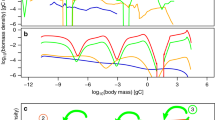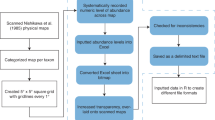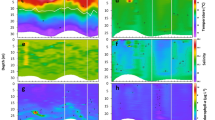Abstract
ONE of us (D. J. G.) is engaged in a statistical study of ring formation in the scales of Tilapia esculenta (Graham) from Lake Victoria. The rings on the scales of this fish are not so much formed by closer grouping of circuli as in temperate species, but rather consist of regions where the circuli are irregular or broken. Such rings are separated by regions where the circuli are regular and complete. Thus ring formation in this species would seem to be due not so much to a slowing of growth, but to continuance of growth in the scale under adverse conditions, resulting in imperfect calcification or formation of matrix.
This is a preview of subscription content, access via your institution
Access options
Subscribe to this journal
Receive 51 print issues and online access
$199.00 per year
only $3.90 per issue
Buy this article
- Purchase on Springer Link
- Instant access to full article PDF
Prices may be subject to local taxes which are calculated during checkout
Similar content being viewed by others
References
Lowe, R. H., “Observations on the Biology of Tilapia (Pisces: Cichlidae) in Lake Victoria, East Africa” (East African Fish. Res. Org. Supp. Pub. No. 1, 1956).
Krogh, A., “Osmotic Regulation in Aquatic Animals” (Camb. Univ. Press, 1939).
Van Someren, V., “A Preliminary Investigation into the Causes of Scale Absorption in Salmon (Salmo salar, Linné)”, No. 2 (Fisheries, Scotland, Salmon Fish., 1937).
Author information
Authors and Affiliations
Rights and permissions
About this article
Cite this article
GARROD, D., NEWELL, B. Ring Formation in Tilapia esculenta . Nature 181, 1411–1412 (1958). https://doi.org/10.1038/1811411a0
Issue Date:
DOI: https://doi.org/10.1038/1811411a0
This article is cited by
-
Tartrate resistant acid phosphatase as a marker for scale resorption in rainbow trout, Oncorhynchus mykiss: effects of estradiol-17? treatment and refeeding
Fish Physiology and Biochemistry (1995)
-
A preliminary study of the age and growth of the Cyprinid fish Barilius moorii Blgr. from Lake Kivu
Hydrobiologia (1984)
-
The growth of Tilapia esculenta Graham in Lake Victoria
Hydrobiologia (1959)
Comments
By submitting a comment you agree to abide by our Terms and Community Guidelines. If you find something abusive or that does not comply with our terms or guidelines please flag it as inappropriate.



